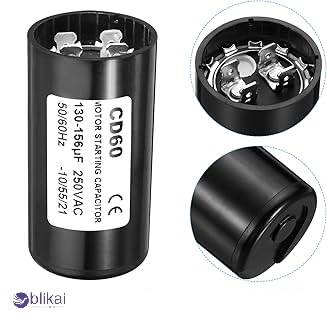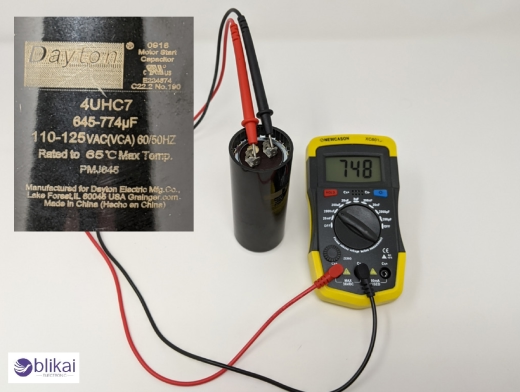How to Test a Motor Capacitor
What Is a Motor Capacitor?
A motor capacitor is one of the most pivotal electrical components in improving electric motors. It basically stores and releases electrical energy so that a phase shift is introduced to the motor's windings. This phase shift forms a rotating magnetic field, ensuring the motor operates efficiently.

Types of Motor Capacitors
- Start capacitors: These provide a high initial torque during motor startup.
- Run capacitors remain in the circuit during regular operation, improving motor efficiency.
How Motor Capacitors Work
Motor capacitors store and release electrical energy and create a phase shift in the main and auxiliary windings of single-phase motors. This creates a rotating magnetic field, enabling the motor to start and run efficiently.
Signs of a Faulty Capacitor
When a capacitor begins to fail, its malfunction can be detected, and timely upkeep becomes feasible. Common signs include:
- The motor fails to start or runs slowly
- Humming or buzzing sounds from the motor
- Intermittent motor operation
- Overheating of the motor
- A burning smell coming from the motor
Preparing for Capacitor Testing
Safety precautions
Safety must be paramount before testing motor capacitors. Always turn off the motor and let it sit for 30 minutes so the capacitors can slowly discharge. Wear insulated gloves and safety goggles to protect from any projected discharges. Bare-hand contacts with the capacitor terminals are not recommended because a charge can still lurk there and give a nasty shock.
Required tools and equipment
Some tools are needed to facilitate the testing of the motor capacitor. The digital multimeter is the most common tool used for this purpose. Make sure that it has a capacitance measuring function. You may also need insulated pliers to handle the capacitor safely and a screwdriver to access the interior of the motor. If the meter is analog, make sure it is set correctly to show accurate readings.
Locating the capacitor in your motor
Next, you will need to identify the location of the capacitor in your motor. In most cases, capacitors are found in a separate container or attached externally to the motor's body. Look for a cylindrical component, usually encased in a metal or plastic housing, often adjacent to the motor's terminals or start switch. If the location is still unclear, check the user manual or schematic diagram of the motor to assist you in locating it.
Visual Inspection
Checking for physical damage
When checking motor capacitors, it is best to start by looking for noticeable physical damage. Inspect the capacitor casing for cracks, dips, or punctures; all indicate internal failure and eventual breakdown. Pay extra attention to the terminals and connectors if they are loose, corroded, or bent.
Identifying bulging or leaking
The capacitor may be on its last legs if you see physical distortion or signs of leaking. You should watch for swelling or distortion in the shape of the capacitor, particularly at the top. However, a suitable capacitor should remain in its original shape. If you notice any oily substance or moisture around the capacitor, it is most likely leaking electrolyte, which means it has failed and must be replaced immediately.
Assessing discoloration
Discoloration can be another sign of trouble with a capacitor. Look on the surface of the capacitor for unusual color variations like browning or blackening. These disfigurements are usually due to overheating or voltage stress. A unique watch must be kept for discoloration around the terminals since this is where most heat-induced coloration starts. Any discoloration means the capacitor was subjected to conditioning beyond its operational specifications.
Multimeter Testing Method
Setting up the multimeter
A few steps must be followed while testing the motor capacitor with a multimeter. Get a digital multimeter with a capacitance setting and set it on that setting. The multimeter setting is often signified by the symbol "F," standing for Farad. Choose a range corresponding to a reasonably expected value of the capacitor you'll be measuring.
Measuring capacitance
Disconnect the capacitor from the motor circuit and discharge it safely. Connect the multimeter probes to the terminals of the capacitor, taking care to observe polarity if it is a polarized capacitor. Wait until the reading settles down; a few seconds should suffice.
Interpreting the results
The measured value is now compared to the capacitor's rated value, which is generally printed on its casing. For the capacitor to be suitable, the estimated value should be within 10% of the rated value. If there's a significant difference in readings between what is printed on the casing and the measured value or reads "OL," the capacitor may be faulty.
Troubleshooting common issues
If your readings are too erratic, ensure that the meter battery is good and again check that both probes maintain contact with the capacitor terminals. Very low or no readings can indicate capacitor shorting. The capacitor could be open if the multimeter doesn't register any value. In either case, replacement is likely necessary.

Analog Meter Testing Method
Using an analog meter for testing
An analog meter, or a Moving Coil Meter, can be a testing instrument for motor capacitors. First, set the meter to its highest resistance range. Next, the meter probes are connected to the terminals of the capacitor with light pressure but with the correct polarity. The red (positive) probe should touch the positive terminal of the capacitor; the black (negative) probe should touch the negative terminal.
Reading the needle movement
When you connect the probes, observe the needle's movement on the meter's display. In a healthy capacitor, the reading will show a quick swing of the needle to zero and then ultimately toward infinity. This reflects the capacitor charging and discharging via the meter's internal circuitry.
Understanding the results
The needle's movement provides valuable information about the capacitor's condition. A quick initial deflection followed by a slow return indicates a suitable capacitor. No movement indicates an open circuit, which is likely a capacitor fault. If the needle does move to zero but remains there, it means a short circuit, indicating capacitor failure. Remember that the different capacitor types may have slightly different behaviors, so you must be familiar with the particular motor capacitor you are testing for accurate interpretation.
Capacitor-Discharge Test
Safely discharging the capacitor
It's crucial to ensure your safety before conducting a discharge test. Start by unplugging the motor and removing the capacitor. Using insulated pliers, carefully connect a 20,000-ohm resistor across the capacitor terminals. This resistor acts as a safe pathway for the stored energy to dissipate. Allow a few minutes for the capacitor to discharge fully.
Observing discharge time
After ensuring the capacitor is adequately discharged, evaluate its performance. Recharge the capacitor for a short time by attaching it to a charger. Then, it is put in the DC voltage mode on the multimeter to measure the voltage across the capacitor terminals. Take down the first voltage reading, start the timer, and see how long it takes for the voltage to drop down to half its original value.
Evaluating capacitor health
The discharge time provides valuable insights into the capacitor's condition. A healthy capacitor should maintain its charge for a considerable period. If the voltage drops rapidly, it indicates a failing capacitor. Compare the observed discharge time with the manufacturer's specifications or industry standards for your specific capacitor type. A significantly shorter discharge time suggests that the capacitor may need replacement.
Installation and Maintenance
Proper installation techniques
The installation of a motor capacitor requires adherence to the manufacturer's official instructions. Start by disconnecting all power and completely discharging the capacitor. Mount the capacitor carefully in clean and secure places away from heat sources and moving parts. Use appropriate connectors and insulation to connect the wires following the motor's wiring diagram. Check that every connection is safely done before you turn on the system.
Safety precautions
Safety first is an important notion regarding self-keys with motor capacitors. Therefore, insulated gloves and insulated handle tools should be used at all times. Never touch the capacitor terminals without first discharging them using a resistor or a discharge tool. The work area should be dry and well-ventilated to minimize the possibility of electrical hazards.
Related Articles
What is a Bypass Capacitor & Why Do You Need One?
Installing a Dual Run Capacitor: What You Need to Know
What is a Ceramic Capacitor and How Does it Work?
What is an Audio Capacitor and Why Does it Matter?
What is the Standard Lead Spacing for Capacitors?
What Is CBB61 Capacitor - Function and Applications
What Causes Capacitors to Fail
Tantalum vs Ceramic Capacitor: What's the Differences?
Run Capacitor vs Start Capacitor
Radial vs Axial Capacitor: Whats the Differences?
Polyester vs Polypropylene Capacitors: Explained
Polarized vs Non-Polarized Capacitor
How to Test a Hard Start Capacitor [Complete Guide]
Series Capacitor Calculator: Full Explained










